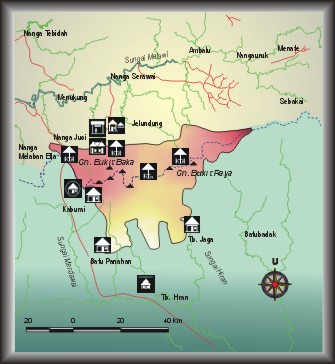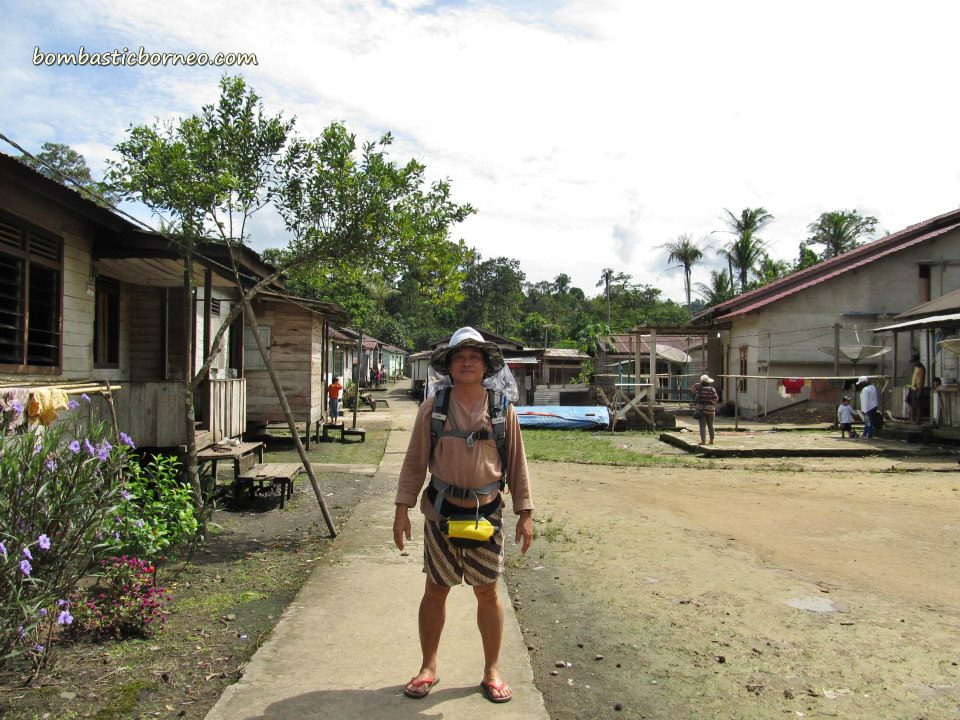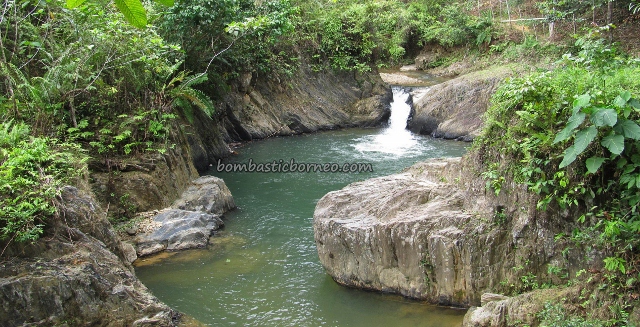Location : Regency of Sintang (Province of West
Kalimantan), and Regency of Kotawaringin
Timur (Province of Central Kalimantan)
Established : 1992
Designated : Minister of Forestry, SK No. 281/Kpts-II/92
Total area : 1,810 km²
Temperature : 7° - 32°C
Rainfall : 3,400 mm/year (on average)
Altitude : 150 - 2,278 m asl.
Coordinates : 0°47′S 112°37′E / 0.783°S 112.617°E
/ -0.783; 112.617
Best time of year to visit : June to September.
Introduction
The forest areas of Bukit Baka-Bukit Raya National Park are dominated by the peaks of the Schwaner range. This forms a mountainous tropical rain forest ecosystem with a relatively high humidity (86%).
Eight hundred and seventeen species of plant have been recorded, belonging to 139 families including Dipterocarpaceae, Myrtaceae, Sapotaceae, Euphorbiaceae and Ericadeae. Also to be found are medicinal plants and plants used for handicrafts, tools and construction materials, and consumption, and various species of forest orchid. There is also the rafflesia (Rafflesia sp.), a giant flower parasite which is assumed to be similar to those growing on Mt. Kinabalu, Malaysia. Among the endemic species are Symplocos rayae, Gluta sabahana, Dillenia beccariana, Lithocarpus coopertus, Sellaginnela magnifica, and Tetracera glaberrima.
The mammals that inhabit this Park include clouded leopard (Neofelis nebulosa), orang utan (Pongo satyrus), sun bear (Helarctos malayanus euryspilus), maroon leaf monkey (Presbytis rubicunda rubicunda), slow loris (Nyticebus coucang borneanus), deer (Cervus unicolor brookei), spotted giant flying squirrel (Petaurista elegants banksi), and spotted civet (Visvessa tangalunga).
Among the bird species are the helmeted hornbill (Rhinoplax vigil), rhinoceros hornbill (Buceros rhinoceros borneoensis), black hornbill (Anthracoceros malayanus), emerald dove (Chalcophaps indica), little cuckoo dove (Macropygia ruficeps), great argus (Argusianus argus grayi), and the Bornean peacock pheasant (Polyplectron schleiermacheri). This is both one of the most elusive pheasants in the world and among the most threatened by human activities.
Rare and unique species of mammal and reptile in the Park include the horned frog (Megophyrs nasuta), green monitor lizard (Varanus prasinus), and bengkarung (Mabouya sp.).
The indigenous people living around the National Park are mostly descended from Dayak tribes like the Limbai, Ransa, Kenyilu, Ot Danum, Malahui, Kahoi, and Kahayan. Of great cultural interest are ancient statues made of belian wood, artworks and other items made of rattan, bamboo and pandan, and ritual ceremonies.
Activities
Bukit Baka (Baka Hill): Climbing, kayaking/canoeing and observing animals and plants. This hill has an altitude of 1,620 m asl. The peak, with an average temperature of 15°- 20° C, is often shrouded in mist. The peak of Bukit Baka can be reached within seven hours from village of Nanga Juoi in Manukung sub-district.
Bukit Raya: Climbing, kayaking/canoeing, observing animals and plants, and cultural tourism. Bukit Raya has an altitude of 2,278 m asl. with a temperature of 7°-10° C at the peak. From the villages of Nanga Jelundung, Rumokoy, Mihipit, Hulu Labang or Birang Merabai, the peak of Bukit Raya can be reached within 3-4 days.
Senamang River, Sepan Apui: Rafting, thermal springs, observing animals and plants.
Ella River: Waterfalls.
Outside the Park area:
Kaburai: Forestry Training and Research Centre.
Tumbang Gagu: Traditional Dayak longhouses (betang).
Getting there
Pontianak-Sintang-Nanga Pinoh by four wheel drive, 9 hours (460 km); then proceed to Nanga Nuak by speedboat, 2.5 hours. The journey from Nanga Nuak to the Park can be covered within 2 hours by four wheel drive. Alternatively, Palangkaraya-Kasongan by four wheel drive, then to Tumbang Samba by speedboat, 3 hours; from Tumbang Samba by speedboat to Tumbang Hiran, 3 hours, and then another 4 hours to the Park.
Contacts
Address : Jl. Dr. Wahidin 75 Sintang 78611, West Kalimantan
Tel /Fax : (+62)565-23521
E-mail : tnbbbr@plasa.com
Source : http://www.dephut.go.id/uploads/INFORMASI/TN%20INDO-ENGLISH/bukitbaka_NP.htm











military backpacks…
[…]below you’ll find the link to some sites that we think you should visit[…]…
Natural Swimming Pools…
[…]down the page you’ll discover the hyperlink to a lot of website pages that we believe you’ll want to check out[…]…
An all ’round great blog..